The NAS's Errors on the Subjectof the Fossil Record
The National Academy of Sciences booklet suggests that the fossil record provides definitive proof of evolution, and even says, "So many intermediate forms have been discovered. . ." and refers to a "huge body of evidence." (Science and Creationism, p. 14) Yet, for some reason not a single example of an intermediate form is provided, even though the book let claims to present "the most important lines of evidence supporting evolution." (Science and Creationism, p. ix) A book making such a claim would be expected to detail the series of intermediate forms in question, and to respond to criticisms directed at the classic putative intermediate forms (such as Archaeopteryx). Yet, no such proof is given in the book, which merely attempts to convince its readers by means of vague words and abstract expressions.
The National Academy of Sciences' attempt to portray the theory of evolution as one for which there is so much evidence reminds one of a doctor who tells a moribund patient who is no longer capable of any movement at all that "You are so healthy, you could get up and go for a run if you wanted," just to keep his spirits up. It seems that the members of the National Academy of Sciences think that a self-confident tone would be enough to save their theory. Yet, what matters is not the tone or style employed, but rather concrete scientific evidence. It is an incontrovertible fact that scientific evidence testifies against Darwinism. Those evolutionists who have not lost their ability to evaluate the scientific evidence objectively accept that the fossil evidence does indeed speak against the theory of evolution. Indeed, this is a self-evident fact.
For example, Henry Gee, the editor of the journal Nature, says in his book In Search of Deep Time that "mountains of evidence" supporting the theory of evolution have not been discovered in the fossil record, and that, on the contrary, the evidence which does exist is evaluated by evolutionists according to their own preconceptions:
Many of the assumptions we make about evolution, especially concerning the history of life as understood from the fossil record, are, however baseless.
The reason for this lies with the fact of the scale of geological time that scientists are dealing with, which is so vast that it defies narrative. Fossils, such as the fossil creatures we hail as our ancestors, constitute primary evidence for the history of life, but each fossil is an infinitesimal dot, lost in a fathomless sea of time, whose relationship with other fossils and organisms living in the present day is obscure. Any story we tell against the compass of geological time that links these fossils in sequences of cause and effect—or ancestry and descent—is therefore only ours to make. We invent these stories, after the fact, to justify the history of life according to our own prejudices. 1
The fact that living species and fossils hundreds of millions of years old are to-- tally similar is very clear evidence against evolution..
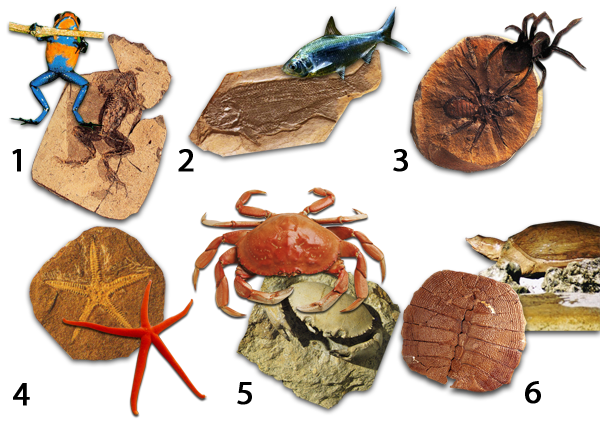
1) A frog fossil approximately 53 to 33.7 million years old.
2) A bony fish fossil dating back some 210 million years.
3) A spider fossil, some 355 to 295 million years old. years.
4) An echinoderm (starfish) fossil dating back some 135 million years.
5) A fossil crab approximately 55 to 35 million years old.
6) An approximately 300-million-year-old trionyx (tortoise) fossil.
Looked at without evolutionist prejudice, it is clear that the fossil record conflicts with the theory of evolution on many points. Some of these areas are:
1. Species and higher categories emerge in a very sudden way in the fossil record, fully formed in their distinct body plans. The intermediate forms claimed by the National Academy of Sciences are nowhere to be found. It has eventually been made clear that those fossils portrayed as transitional forms by evolutionists have been interpreted in a biased manner by scientists. None of the few fossils portrayed as intermediate forms has ever received wide acceptance, not even amongst evolutionists. The truth is that the evidence for these alleged transitional forms (species or genera such as Archaeopteryx, Ambulocetus or Australopithecus) rests on evolutionists' comparisons of certain anatomical features of the extinct creatures in question with other species. Yet these comparisons are weak and superficial. Furthermore, the great differences between these so-called transitional forms and their so-called closest evolutionary relatives (between Archaeopteryx and theropod dinosaurs, for instance, or Ambulocetus and ancient whales, or Australopithecus and Homo erectus) show that these are not transitional forms representing the gradual changes expected by Darwin. The more the fossil record grows, the more these huge gaps can be seen to be real and permanent.

During the Cambrian Period, the Earth was suddenly filled with nearly 100 phyla. The fact that all these living things, which all possessed their own particular and unique physical structures, emerged without a common ancestor is clear proof that they were created.
2. The second area of conflict between the theory of evolution and the fossil record is that of stasis. It can be seen from the fossil record that there is no gradual change towards different physical forms, but rather a stability or lack of change.
3. The order of geological succession is also against the theory's expectations. The theory of evolution maintains that small evolutionary changes gradually accumulated. If this were true, we would expect that more primitive classes first experienced variation within themselves, which gradually led to different and more complex body plans. In other words, according to the theory of evolution, variation must come before differentiation. However, geological succession—that is, the fossils' positions in the geological strata—shows just the opposite: differentiation comes before variation. In the Cambrian Period, very different basic body plans appear all of a sudden, with no evolutionary ancestors lower down. Variations then follow these previously existing forms. The natural history of life is systematically from the top down, not from the bottom up, as Darwinist theory would have it.
Let us briefly examine this conflict between the theory of evolution and the fossil record.
The Ever-Missing Transitional Forms
Darwin imagined evolution to consist of gradual transitions from one species to another over long periods of time. There should therefore be an infinite number of intermediate links between species. Darwin stated as much in The Origin of Species:
... The number of intermediate varieties, which have formerly existed on the earth, [must] be truly enormous. Why then is not every geological formation and every stratum full of such intermediate links? Geology assuredly does not reveal any such finely graduated organic chain; and this, perhaps, is the most obvious and gravest objection which can be urged against my theory. 2
Again in The Origin of Species, Darwin stated that the sudden emergence of phyla with no evolutionary ancestors below them represented a serious difficulty:
… There is another and allied difficulty, which is much more serious. I allude to the manner in which species belonging to several of the main divisions of the animal kingdom suddenly appear in the lowest known fossiliferous rocks.3
The serious difficulty referred to by Darwin in this passage continues to be a serious difficulty today. The evidence that he expected to show the evolution of one species from another is nowhere to be found. The fact that there are no transitional forms between species in the fossil record is so clear-cut that a great many evolutionists have been forced to admit it. A selection of these confessions follows:
Professor S.M. Stanley of Johns Hopkins University:
The known fossil record is not, and never has been, in accord with gradualism. What is remarkable is that, through a variety of historical circumstances, even the history of opposition has been obscured. . . . 'The majority of palaeontologists felt their evidence simply contradicted Darwin's stress on minute, slow, and cumulative changes leading to species transformation.' . . . their story has been suppressed.4
Professor of Philosophy and Zoology Michael Ruse:
One must acknowledge that there are many, many gaps in the fossil record... There is no reason to think that all or most of these gaps will be bridged.5
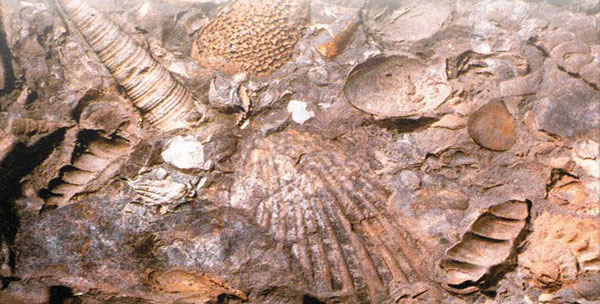
Anthropologist Ian Tattersall and palaeontologist Niles Eldredge of the American Museum of Natural History:
The record jumps, and all the evidence shows that the record is real: the gaps we see reflect real events in life's history—not the artifact of a poor fossil record.6
Rudolf A. Raff, director of Indiana University's Molecular Biology Institute, and Indiana University researcher Thomas C. Kaufmann:
The lack of ancestral or intermediate forms between fossil species is not a bizarre peculiarity of early metazoan history. Gaps are general and prevalent throughout the fossil record.7
Ernst Mayr, possibly the most prominent biologist of the twentieth century:
Paleontologists had long been aware of a seeming contradiction between Darwin's postulate of gradualism . . . and the actual findings of paleontology. Following phyletic lines through time seemed to reveal only minimal gradual changes but no clear evidence for any change of a species into a different genus or for the gradual origin of an evolutionary novelty. Anything truly novel always seemed to appear quite abruptly in the fossil record.8
The way that the National Academy of Sciences ignores or else seeks to conceal from its readers the existence of Darwinism's fossil problem, to which Darwin drew attention 150 years ago and which is accepted by many modern-day evolutionists, ill-becomes an institution claiming scientific respectability. Some evolutionists who have no hesitations about admitting the dilemmas facing the theory of evolution, such as Stephen Jay Gould, accept that the fossil record is a "persistent and nagging problem"9 for the theory of evolution, and the way that the National Academy of Sciences tries to ignore these findings naturally casts a long shadow over its scientific credibility.
Stasis in the Fossil Record
"Stasis" means lack of biological change, and that in turn means the absence of evolution. That is indeed the case, because in the fossil record a species exhibits no changes during its lengthy geological lifespan. It exhibits statis—in other words its form remains the same—from its very first appearance in the fossil record until its disappearance. Stephen Jay Gould first announced that the fossil record conflicted with the theory of evolution in the 1970s:
The history of most fossil species includes two features particularly inconsistent with gradualism:
1. Stasis. Most species exhibit no directional change during their tenure on earth. They appear in the fossil record looking much the same as when they disappear; morphological change is usually limited and directionless.
2. Sudden appearance. In any local area, a species does not arise gradually by the steady transformation of its ancestors; it appears all at once and "fully formed."10

A 25-million-yearold termite fossil in amber.
In the years that followed, Gould stated in other occasions, too, that he accepted the stasis observed in the fossil record. In an article in Natural History magazine in 1988, he wrote:
[W]ell represented species are usually stable throughout their temporal range, or alter so little and in such superficial ways (usually in size alone), that an extrapolation of observed change into longer periods of geological time could not possibly yield the extensive modifications that mark general pathways of evolution in larger groups. Most of the time, when the evidence is best, nothing much happens to most species.11
As can be seen from these words, Gould admits that a great many species underwent no changes. In another article in the same magazine, published in 1993, he wrote:
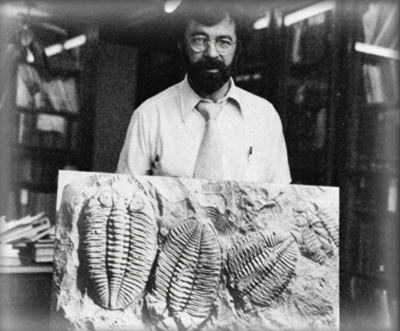
Niles Eldredge
[S]tasis, or nonchange of most fossil species during their lengthy geological lifespans was tacitly acknowledged by all paleontologists, but almost never studied explicitly because prevailing theory treated stasis as uninteresting nonevidence for nonevolution . . . [T]he overwhelming prevalence of stasis became an embarrassing feature of the fossil record, but left ignored as a manifestation of nothing (that is, nonevolution).12
Ian Tattersall and Niles Eldredge, in their book The Myths of Human Evolution, described the contradiction between the fossil record and the assumptions of Darwinism, and stated that stasis was a fact:
Paleontologists just were not seeing the expected changes in their fossils as they pursued them up through the rock record . . . That individual kinds of fossils remain recognizably the same throughout the length of their occurrence in the fossil record had been known to paleontologists long before Darwin published his Origin. Darwin himself, . . . prophesied that future generations of paleontologists would fill in these gaps by diligent search . . . One hundred and twenty years of paleontological research later, it has become abundantly clear that the fossil record will not confirm this part of Darwin's predictions. Nor is the problem a miserably poor record. The fossil record simply shows that this prediction is wrong.
The observation that species are amazingly conservative and static entities throughout long periods of time has all the qualities of the emperor's new clothes; everyone knew it but preferred to ignore it. Paleontologists, faced with a recalcitrant record obstinately refusing to yield Darwin's predicted pattern, simply looked the other way.13
The Bat: Unchanged For 50 Million Years
ne of the living species that suddenly appear in the fossil record, proving that none of these species ever underwent any changes throughout the length of their occurrence in the fossil record, is the bat. The fact that the oldest fossil bats are identical to those of the present day shows that these creatures have come down unchanged to modern times. Even evolutionists admit in evolutionist sources that this fact represents a terrible quandary for their theory. The evolutionist scientist Jeff Hecht expresses this fact in these terms:
[T]he origins of bats have been a puzzle. Even the earliest bat fossils, from about 50 million years ago, have wings that closely resemble those of modern bats.1
As we have seen, fossils totally undermine the claims of the theory of evolution. Had evolution really taken place, then we should have found a fossil which was in the process of turning into a bat. Yet, the bat is the same now as it was 50 million years ago. This is a major problem for the idea of bat evolution. The evolutionist scientist Jeff Hecht admits this:
[I]t may be difficult to find an intermediate form that shows how bats evolved their wings.2
Evolutionists are well aware that the present-day fossil record is exceedingly rich. The NAS states the fact in its own booklet. Yet, no trace has been found of the imaginary creature assumed to have been the ancestor of the bat.
1- Jeff Hecht, 'Branching Out', New Scientist, 10 Ekim 1998, cilt 160, sayı 2155, s. 14
2- Jeff Hecht, 'Branching Out', New Scientist, 10 Ekim 1998, cilt 160, sayı 2155, s. 14

A bat fossil approximately 33.7 to 53 million years old.
The NAS's Errors Regarding Geological Succession
According to the National Academy of Sciences, living species are ranged in the fossil record from the simplest to the most complex. In other words, those living species with the simplest forms are found in the lowest strata, and this complexity increases until the appearance of man. This is a Darwinist expectation and the dream of which evolutionists hope to find proof in the fossil record.
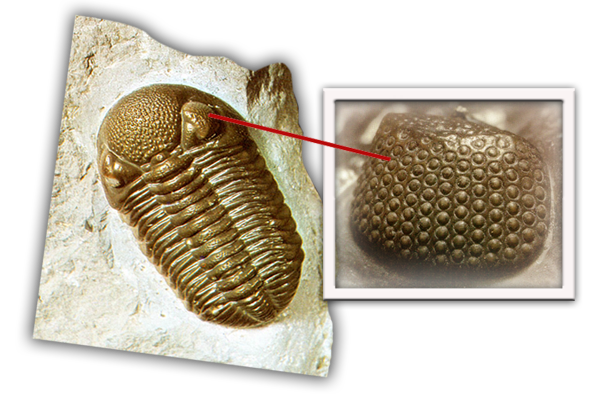
Trilobites lived during the Cambrian Period and possessed an exceedingly complex eye structure.
It first needs to be made clear that living species in the Earth's strata do not follow a progression from the simple to the complex. For instance, the trilobites, which lived in the Cambrian Period when the first animal phyla appear, possessed a rather complex eye structure. A trilobite eye consists of hundreds of tiny facets, each of which contains two lens layers. This eye structure is a marvel of design. David Raup, a professor of geology at Harvard, Rochester, and Chicago universities, says that, "the trilobites 450 million years ago used an optimal design which would require a well trained and imaginative optical engineer to develop today." 14

Modern-day insects like the dragonfly possess the same eye structure as the trilobite.
Another point which needs to be made clear about trilobites is that the 530-million-year-old compound eye system has come down unchanged to the present day, and that some insects, such as the bee or the dragonfly, today possess exactly that same structure.15 This finding deals a mortal blow to the theory of evolution's claim that living things developed directly from the simple to the complex.
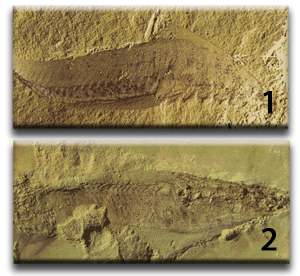
1) Myllokunmingia fengjiaoa
2) Haikouichthys ercaicunensis
A new discovery in 1999 revealed two fish species that lived in the Cambrian Period.
The fossils found in Cambrian strata belong to very different species, such as snails, trilobites, sponges, worms, star fishes, sea urchins, and sea lilies. A new discovery in 1999 even revealed the existence of two separate fish species, Haikouichthys ercaicunensis and Myllokunmingia fengjiaoa. Most of the living things in this stratum possessed advanced physiological structures and complex systems, such as the eye, the lung, and a circulatory system, which are no different from those of modern-day specimens. These structures are both very complex and very different from one another. The NAS's claim that life evolved from the primitive to the advanced is therefore very definitely untrue.
Professor Phillip Johnson of the University of California, Berkeley, one of the most important critics of Darwinism in the world, declares that this fact revealed by paleontology openly conflicts with Darwinism:
Darwinian theory predicts a "cone of increasing diversity," as the first living organism, or first animal species, gradually and continually diversified to create the higher levels of taxonomic order. The animal fossil record more resembles such a cone turned upside down, with the phyla present at the start and thereafter decreasing.16
Finally, it needs to be made clear that it is a mistake to portray living species' arrangement in geological strata as proof of the claim that species evolved from one another. In order to prove their claims, evolutionists need to be able to point to fossils belonging to transitional species, thus demonstrating an evolutionary transition between different species. However, as we have seen in the preceding pages, there is no sign of such intermediate forms. In conclusion, the NAS's "self confident" statements about the fossil record are actually hollow claims, devoid of proof and used solely for propaganda purposes.
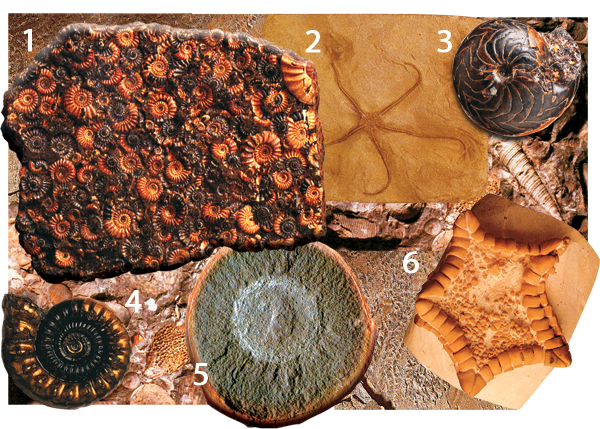
1) Fossil ammonites some 203 million years of age.
2) A 400-million-year-old brittle star fossil.
3) A 355 to 295-million-yearold shelled mollusc.
4) A 203-million-year-old ammonite.
5) An approximately 300-million-year-old jellyfish.
6) A starfish dating back some 65 million years.
NOTES
1. Henry Gee, In Search of Deep Time, Ithaca: Cornell University Press, 1999, pp. 1-2.
2. Charles Darwin (1859), The Origin of Species (Reprint of the first edition), New York: Avenel Books, Crown Publishers, 1979, p. 292.
3. Charles Darwin (1859), Origin of Species, Chapter 9, On the Imperfection of the Geological Record; http://www.literature.org/authors/darwin-charles/the-origin-of-species/chapter-09.html
4. S.M. Stanley, The New Evolutionary Timetable: Fossils, Genes and the Origin of Species, New York: Basic Books, Inc Publishers, p.71
5. Michael Ruse, "Is There a Limit to Our Knowledge of Evolution," Commentary in Bioscience, vol.34, no.2, p. 101; Also printed in (editor) But Is it Science? Philosophical Question in the Creation/Evolution Controversy, New York: Promotheus Books, Buffalo, 1988, pp. 116-126.
6. Niles Eldredge and Ian Tattersall, The Myths of Human Evolution, Columbia University Press, 1982, p. 59.
7. R. A. Raff and T. C. Kaufman, Embryos, Genes and Evolution: The Developmental Genetic Basis of Evolutionary Change, Indiana University Press, 1991, p. 34.
8. Ernst Mayr, One Long Argument: Charles Darwin and the Genesis of Modern Evolutionary Thought, Massachusetts: Harvard University Press, 1991, p. 138.
9. S. J. Gould, "Is a new and general theory of evolution emerging?," in Maynard Smith editor, 1982, p. 140. (emphasis added)
10. S. J. Gould, The Panda's Thumb, W. W. Norton & Company, New York, 1980, p. 182.
11. S. J. Gould, "Ten Thousand Acts of Kindness," Natural History, vol. 97, no.12, December 1988, p. 14.
12. S. J. Gould, "Cordelia's dilemma," Natural History, February 1993, pp. 10-18.
13. Niles Eldredge and Ian Tattersall, The Myths of Human Evolution,Columbia University Press, 1982, pp. 45-46
14. David Raup, "Conflicts Between Darwin and Paleontology," Bulletin, Field Museum of Natural History, vol. 50, January 1979, p. 24.
15. R. L. Gregory, Eye and Brain: The Physiology of Seeing, Oxford: Oxford University Press, 1995, p. 31.
16. Phillip E. Johnson, "Darwinism's Rules of Reasoning", Darwinism: Science or Philosophy, Foundation for Thought and Ethics, 1994, p. 12.
- Introduction
- The nas's error regarding the origin of life
- The nas's error on natural selection
- The nas's errors regarding mutations
- The nas's errors regarding speciation
- The nas's errors on the subject of the fossil record
- The nas's error in portraying common structures as evıdence of evolution
- The nas's error ın portraying the distribution of species as evidence of evolution
- The nas’s misconception about embryology
- The nas's error in portraying molecular biology as evidence of evolution
- The nas's human evolution error
- The nas's errors in the chapter on creationism and the evidence for evolution
- Creation ıs a scientific fact
- Conclusion
